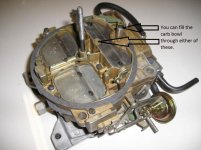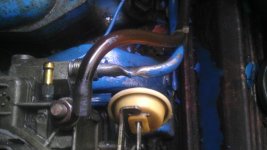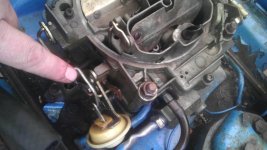So far I've pumped out some oil and didn't find any water, removed & cleaned spark plugs, sprayed into cyliders with light oil, removed valve covers, sprayed with light oil. Turned both engines by hand then cranked with starter before putting plugs/valve covers back in & cranking.
There now seems to be no fuel getting to the carburator or anywhere else that I can tell. I have two filters on each engine, the second an AC canister and it was dry on one side and about a fifth full on the other, haven't pulled the other filter (fuel/water seperator) yet but planning on replacing all and filling them up with gas. Not sure if there is a malfunction in the fuel pump though, how would I know? I have put a volt meter on the connections and there is power to the fuel pump. The fuel pump is an electric AC Declo.
Any suggestions would be appreciated.
Kevin
There now seems to be no fuel getting to the carburator or anywhere else that I can tell. I have two filters on each engine, the second an AC canister and it was dry on one side and about a fifth full on the other, haven't pulled the other filter (fuel/water seperator) yet but planning on replacing all and filling them up with gas. Not sure if there is a malfunction in the fuel pump though, how would I know? I have put a volt meter on the connections and there is power to the fuel pump. The fuel pump is an electric AC Declo.
Any suggestions would be appreciated.
Kevin





